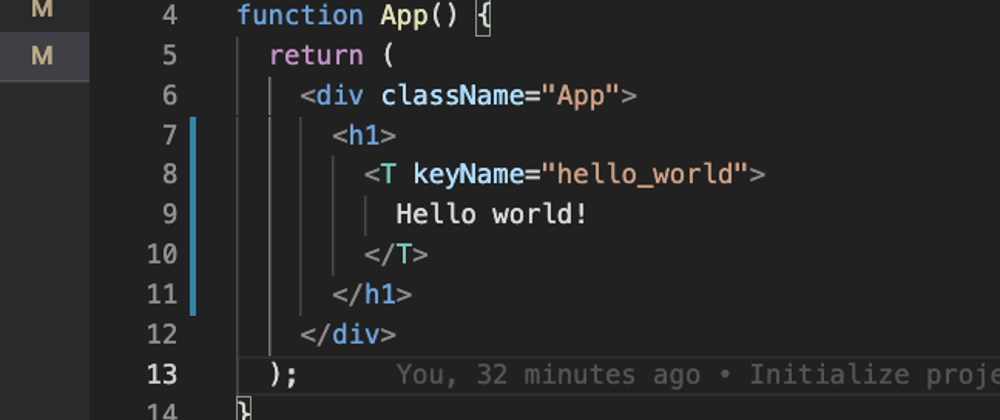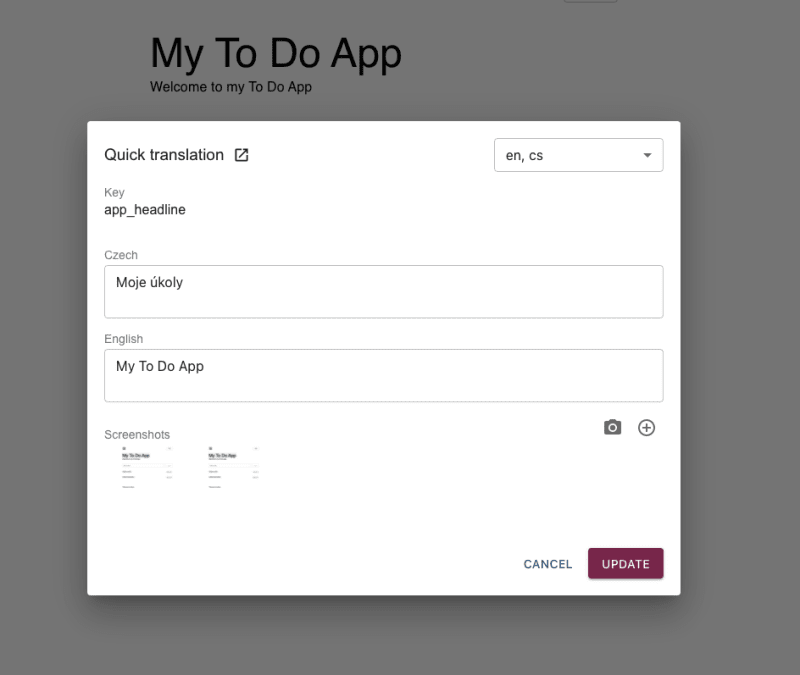Translating an App to multiple languages (localization) is tricky part of many applications. Tolgee is simplifying the localization process and saves developer's time 👨💻👩🏻💻 by removing repetitive tasks 🔁 ❌. Saving time? That's what I want. Show me!
What is Tolgee
Tolgee is open-source tool combining localization platform and SDKs to provide simple way to translate the web applications for both developers and translators. 👨💻👩🏻💻🧖🏼👩🏻💻🧖🏼
In context translating 📖
As a developer of localized application, you probably have to modify localization data every time you need to change a text. So you have to open the file, add or find the key to modify, save it and check whether everything was changed correctly in the app. With Tolgee you can just ALT + click the actual translated text in your app and 💥boom💥 translation dialog appears and you are able to translate it right away.
Automatic Screenshot Generation 📸
Another tricky part of localization is providing context 📖 to translators. Only exporting the keys and translations in source language is not always enough. Tolgee enables you to take and upload screenshot directly in the in-context translation dialog. So no more manual taking and uploading screenshots.🌄
Localization platform included ✅
Tolgee is also localization platform, where you can manage all your localization strings 📚. So you can provide access to translators and they can translate the texts there. If you uploaded screenshots before, they know the context of the translations perfectly so they can produce perfect results.
Isn't that hard to integrate? No it's not!
To get started, you can simply follow the integration guides provided in the platform. Which is the simplest way to get started.
Login to Tolgee Cloud or use your self hosted Tolgee instance.
-
Create a new project by clicking
Addbutton in the top right. And filling the project name.Optionally, you can add multiple languages to translate your app into.
-
Select
Integratefrom side menu, choose React and generate an API key with all scopes checked. Success! 🎉 Now you just have to follow the integration guide.
Let's integrate it into CRA App
-
Generate brand new CRA App and open it your favorite editor
npx create-react-app tolgee-hello-world -
Install Tolgee packages ⬇️
npm install @tolgee/react @tolgee/ui --save -
Add Tolgee properties to you development
.envfileenv.development.localby copying it from the integration guide
REACT_APP_TOLGEE_API_URL=https://app.tolgee.io REACT_APP_TOLGEE_API_KEY=<your API key> Wrap your App component in
index.jswithTolgeeProvidercomponent. Again, you can copy it from the integration guide.-
Go to
App.jsand replace all the crap with simple "Hello world!" message.
import './App.css'; function App() { return ( <div className="App"> <h1>Hello world!</h1> </div> ); } export default App; -
Wrap the "Hello world!" with
<T>component and add keyName prop.
import './App.css'; import { T } from '@tolgee/react' function App() { return ( <div className="App"> <h1><T keyName="hello_world">Hello world!</T></h1> </div> ); } export default App; -
Let's run the App in the browser and see the magic! 🪄 Hold your ALT key and move your mouse over the text. It should be highlighted. When you click it, dialog opens and you're able to edit the text ✏️ or generate screenshots. 📷

After you hit the update button, yourHello World!text will be immediately changed to the new value!
Congratulations! You're done! 🎉🎉🎉
You can find the resulting code in this GitHub repo, but you have to add your .env.development.local file.
Now you are able to translate your Applications with Tolgee. To learn more about Tolgee or to find out how to translate more complicated cases, visit our docs.
TL;DR
Tolgee is open-source tool simplifying the process of web based application. It has this features:
- It's open-source
- You can translate in the context of your App
- You can generate screenshots automatically
- You should use it and save time!
🙏🙏🙏 If you like what we do, please star our GitHub projects. 🙏🙏🙏












Top comments (7)
We don't think that screenshots are "kinda out of scope". When you localize application into more languages, you would probably need translators to do the job for you. The translators produce inaccurate results, when they don't know the context of the strings. That is why Tolgee has the screenshot generation feature. To provide context to translators which can simply find out where on the page the actual string is.
Does Tolgee support offline?
It does. You can export files in jsons and use them in production.
@tolgee/reacthas support for SSR. It is described in docs. :)Do I have a self-hosted option?
Yes, you have. See self hosting doc page.
Yes, you can import .po (gettext), xliffs of jsons. Currently it supports export just to jsons, since jsons is supported by out SDKs.
i18next doesn't have the cool features like out-of-the-box in-context localization or screenshot generation.
Basically i18next or react-intl are libraries, that are working with some kind of static data stored in jsons. They are basically changing the strings in your app according to current language. Tolgee is complex tool including a localization platform, where you can manage your strings, so you don't have to find any other editor to your localization data.
People try to create a SaaS out of everything which is ok but no chance that this will replace i18next or similar for me.
Why so?
Because there is no need for something like i18n to be moved to some SaaS it just adds complexity to the whole project and you are probably doing unnecessary Network calls using this service unless you export the JSON from this SaaS and use it in production which is then anyway the same as not using the service, so why should I use this just to look at my strings in a nice designed dashboard and edit them? Who thinks he needs this ok but I think its unnecessary.
First of all, when you are translating your app into multiple languages, the development is full of repetitive tasks. Extracting the keys, modifying the localization files etc. It you are translating to multiple languages, then you would be probably annoyed with those tasks.
The more important part is providing context to translators. When you localizing your app into languages you don't know, then you have no way how to check, that your translators provided accurate translations. Without context, you can be sure, that they will provide inaccurate translations.
The thing is, that it's not just developers who needs to manipulate the strings. It's also translators, who don't understand and sometimes can't even access the code of the app.
You are right maybe I'm thinking wrong about this, I will check it out and let you know.